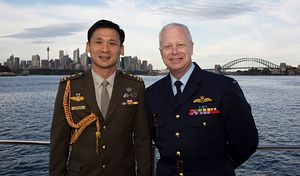I’m late to the story here, but Singapore and Australia signed a large defense deal in May and expanded their free trade agreement, the SAFTA, first signed in 2003, the first for Australia since a 1983 deal with New Zealand. Australia and Singapore have had a generally strong friendship, and one better than Australia enjoys with much of Southeast Asia. Perhaps that’s why it captures the attention less than the stormier one with large and proximate Indonesia or the trade-based one with China.
Michael Barr of Flinders University suggests that this defense deal benefits Singapore more than it does Australia, despite the paycheck for Canberra and Queensland and apparent knock-on values, such as troops’ families visiting and benefiting the tourism sector. That said, while it is not “risk free” it is largely a deal with few downsides for Australia either, he wrote.
The deal had decent media coverage but possibly not even as much as the “propaganda” deal between China Daily and Fairfax Media. It has not really captured the imagination, nor has it worried many considering how many foreign troops will be training on Australian shores. Were a similar deal inked with Indonesia would there be more scrutiny and questions?
The third upgrading of the SAFTA might be welcome but similarly it hasn’t generated the interest of the ChAFTA. Singapore is Australia’s fourth largest two-way trade partner, and the largest in Southeast Asia. The new deal also means there will be a “focus on skills, mobility, and education… rather than the usual removal of trade tariffs,” according to a Pricewaterhousecoopers press release.
Australia and Singapore have a Comprehensive Strategic Partnership, signed in 2015, with a strong foreign affairs and defense focus. A look at what Australia and Singapore have been working on can be seen here in the joint communiqué of the ninth ministers’ meeting.
Singapore will increase the size of its bases and the number of its troops (from 6000 troops to 14,000) at Queensland bases like Shoalwater Bay, which is three times the size of the city-state, in a A$2.25 billion deal ($1.66 billion). For a country with little land, this matters.
Some pretty significant government attention was given to this deal. Prime Minister Malcolm Turnbull, Trade Minister Andrew Robb, and Minister for Trade and Investment Steven Ciobo gave a joint press conference to journalists to explain, and cheer lead, the new arrangement. The entire transcript goes on for a while and if you want to understand the political overtones look at Turnbull’s beginning: “jobs and growth,” his three-word tagline for the July election.
Despite the talking up of trade and ties between Singapore, questions and answers came back to somewhere else: China. What does this defense deal mean for China, given that it gives Singapore some stronger bases and what Euan Graham at the Lowy Institute calls “strategic depth,” while offering Australia some deeper and forward momentum into the region? The ministers brushed this aside, preferring to speak on trade and noting that relationships are not zero sum: You can strengthen a relationship with one nation without harming another. Certainly, but when it comes to defense this has not always been Beijing’s view.
Then again, the deal’s real strength lies in the non-tangible according to Graham, and the main attributes are “a shared mindset, a compatible strategic outlook, and a willingness to commit for the long term.”
































